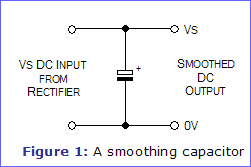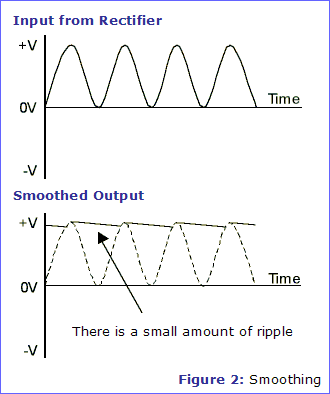Smoothing
By Tim Surtell
Most circuits will require 'smoothing' of the DC output of a rectifier, and this is a simple matter since it involves only one capacitor, as shown in figure 1.
| Further Information | Capacitors |

The output waveform in figure 2 shows how smoothing works. During the first half of the voltage peaks from the rectifier, when the voltage increases, the capacitor charges up. Then, while the voltage decreases to zero in the second half of the peaks, the capacitor releases its stored energy to keep the output voltage as constant as possible. Such a capacitor is called a 'smoothing' or 'reservoir' capacitor when it is used in this application.

If the voltage peaks from the rectifier were not continually charging up the capacitor, it would eventually discharge and the output voltage would decrease all the way down to 0V. The discharging that does occur between peaks gives rise to a small 'ripple' voltage. The amount of ripple is affected by a combination of three factors:
If you want to calculate the ripple voltage, you can use this formula...
![]()
...where Vr is the ripple voltage in Volts, I is the current taken by the circuit in Amps, C is the value of the smoothing capacitor in Farads, and F is the frequency of the peaks from the full-wave rectifier, in Hertz. This frequency will be double the normal mains frequency, i.e. 100Hz in the case of the UK mains supply, or 120Hz in the case of the US mains supply.
The ripple voltage should not be more than 10% of Vs - if it is, increase the value of the smoothing capacitor.
Lots of circuits will work fine from a smoothed power supply, but some must have a completely regular supply with no ripple voltage. The next article in this series discusses regulators which can provide this regular power supply.
| Related Articles | Building a Power Supply - Part 1 of this series | |||||
| The Transformer - Part 2 of this series | ||||||
| The Rectifier - Part 3 of this series | ||||||
| The Regulator - Part 5 of this series |
Article Information
Source: Electronics in Meccano - www.eleinmec.com
| First published in EiM: Issue 4 (June 1999)
Topic: Analogue Electronics |
Created: 02/05/2003 |
Last modified: 02/09/2007
Top of Page | Homepage | About | Search | Topics | Features | Circuits Shop | yourEiM |
© 1998 - 2024 Tim Surtell |